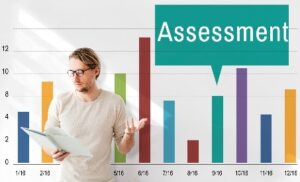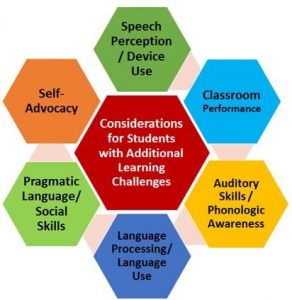Assessment of Students with Hearing Loss MUST Consider Their Full Range of Needs
Speech Language Results and Observation Alone are Insufficient
S.P. v. East Whittier City School District, Pasadena, California
 One June 1, 2018, the Ninth Circuit Court of Appeals reversed and remanded the district court’s decision in favor of the plaintiff (parents) on the grounds that the East Whittier City School District violated the Individuals with Disabilities Education Act (IDEA) “by tying S.P.’s eligibility for special education services to only her speech and language disorder and not also her hearing impairment.” The District also failed to provide S.P. a FAPE by using insufficient evaluative measures to disqualify her from eligibility as a student with a hearing impairment.
One June 1, 2018, the Ninth Circuit Court of Appeals reversed and remanded the district court’s decision in favor of the plaintiff (parents) on the grounds that the East Whittier City School District violated the Individuals with Disabilities Education Act (IDEA) “by tying S.P.’s eligibility for special education services to only her speech and language disorder and not also her hearing impairment.” The District also failed to provide S.P. a FAPE by using insufficient evaluative measures to disqualify her from eligibility as a student with a hearing impairment.
To arrive at this decision, the appellate court addressed two questions: 1) Did the Whittier City School district comply with evaluation procedures set forth in IDEA? and if failing to do so; 2) Did the Whittier City School district deny the student a Free and Appropriate Public Education (FAPE)?
Part 1: DHH eligibility needs to look beyond just speech and language
IDEA requires that a student’s Individualized Education Plan (IEP) “determine whether a child is a child with a disability”, and “determine the educational needs of such child.” 20 U.S.C. § 1414(a)(1)(C)(i). By tying the student’s special education services only to her speech and language disorder and not her hearing impairment as well, the appellate court judged the District violated IDEA. Under California Education Code § 56333 (e), a student may be eligible for special education services if it is determined that the hearing loss results in a language or speech disorder and significantly affects educational performance. One of the District’s mistakes was to base their eligibility criteria for hearing impairment solely on the definition of “Deaf” (“a hearing impairment so severe that the child is impaired in processing linguistic information through hearing with or without amplification, and adversely affect a child’s educational performance.”) 34 C.F.R. § 300.8 (c)(3), and ignore the definition of “hearing impairment”. Defined, “hearing impairment” is “an impairment in hearing, whether permanent or fluctuating, that adversely affects a child’s educational performance.” Id. § C.F.R.300.8 (c)(5). What does all of this mean? A student who receives special education for a speech or language disorder due to a hearing loss (see definition of “hearing impairment”) may also be eligible to receive services for that hearing loss.
Part 2: Assessment must occur to identify a student’s full range of needs
 In determining the student eligible for speech and not as a child with a hearing impairment, the district court recognized that the error in classification (meaning the absence of the HI eligibility) “was harmless because the District otherwise provided S.P. with a FAPE.” However, by basing their decision not to qualify a hearing-impaired student on weak methods (see Part 3) as a child with a hearing impairment, the District denied her a FAPE, therefore it was not “harmless.” Why? 20 U.S.C. §1414 (d)(3)(B)(iv) states that for deaf or hard of hearing students, the IEP team “must consider the child’s language and communication needs, opportunities for direct communications with peers and professional personnel in the child’s language and communication mode, academic level, and full range of needs.” Because the IEP only addressed goals for speech and language, her range of needs due to her hearing impairment specifically were not assessed or considered.
In determining the student eligible for speech and not as a child with a hearing impairment, the district court recognized that the error in classification (meaning the absence of the HI eligibility) “was harmless because the District otherwise provided S.P. with a FAPE.” However, by basing their decision not to qualify a hearing-impaired student on weak methods (see Part 3) as a child with a hearing impairment, the District denied her a FAPE, therefore it was not “harmless.” Why? 20 U.S.C. §1414 (d)(3)(B)(iv) states that for deaf or hard of hearing students, the IEP team “must consider the child’s language and communication needs, opportunities for direct communications with peers and professional personnel in the child’s language and communication mode, academic level, and full range of needs.” Because the IEP only addressed goals for speech and language, her range of needs due to her hearing impairment specifically were not assessed or considered.
Source: https://codes.findlaw.com/ca/education-code/edc-sect-56333.html
Source: https://www.law.cornell.edu/cfr/text/34/300.8
Source: https://www.law.cornell.edu/uscode/text/20/1414
Part 3: All suspected areas of the disability need to be evaluated
Because the impact of S.P.’s hearing loss and consequent needs were not considered, IDEA’s requirement of assessing students in “all areas of suspected disability” was not met. S.P. underwent assessments heavily focused on her speech and language disability. S.P.’s parents produced an audiogram, but the District was still under obligation to conduct a full and individual evaluation in all areas suspect of disability, which it did not do. The District’s assessment of S.P.’s auditory skills consisted only of “observation and review of records.” The appellate court judged that “such a limited review was insufficient to satisfy the District’s evaluative obligation.”
Because the District violated S.P.’s procedural rights under the IDEA and denied her a FAPE, the appellate court reversed and remanded the district court’s decision calling for it “to determine the appropriate remedy.”
What do the results of this court case mean for teachers of students with hearing loss?
 It is inappropriate to consider speech and language results only as primary determinants of eligibility for students with hearing loss. School teams must assess more broadly, and more appropriately to identify a student’s full range of needs in areas most vulnerable to impact on educational performance. Formal and informal data in all areas of suspected disability are necessary for a FAPE under IDEA. Observation can certainly be a part of an evaluation, but it is not a rigorous enough assessment of all areas of potential need. Refer to Steps to Assessment and information within the Supporting Success website for more information on areas of development that should be assessed for students with hearing loss.
It is inappropriate to consider speech and language results only as primary determinants of eligibility for students with hearing loss. School teams must assess more broadly, and more appropriately to identify a student’s full range of needs in areas most vulnerable to impact on educational performance. Formal and informal data in all areas of suspected disability are necessary for a FAPE under IDEA. Observation can certainly be a part of an evaluation, but it is not a rigorous enough assessment of all areas of potential need. Refer to Steps to Assessment and information within the Supporting Success website for more information on areas of development that should be assessed for students with hearing loss.
Think of it this way: Would you accept or question an IEP team’s decision to qualify a student as intellectually disabled because a school specialist simply observed the child in a classroom setting without administering any formal intelligence tests? Of course not!
By Brenda Wellen, M.S., Education of the Deaf for August Bimonthly Update, Supporting Success for Children with Hearing Loss. http://successforkidswithhearingloss.com
